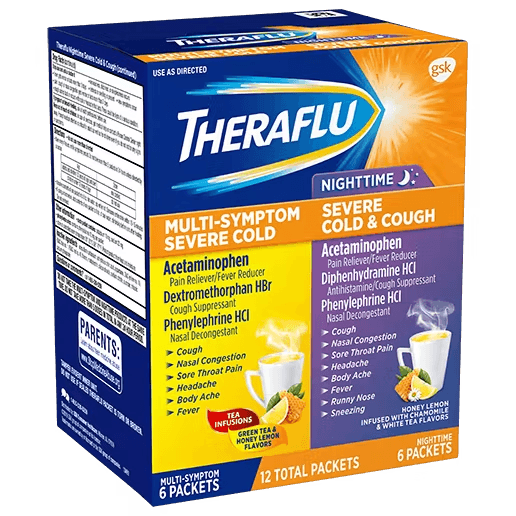TheraFlu Flu & Cough


Antitussive and expectorant drugs
Dextromethorphan HBr 10 mg and Guaifenesin USP 200 mg (per capsule) are the active ingredients.
Inactive ingredients: carnauba wax, cellulose, colloidal silicon dioxide, crospovidone, D&C Yellow No. 10 Aluminum Lake,FD&C Blue No. 1 Aluminum Lake, gelatin, hypromellose, magnesium stearate, microcrystalline cellulose, polyethylene glycol, polysorbate 80, povidone, pregelatinized starch, sodium lauryl sulfate, titanium dioxide.
TheraFlu Flu & Cough capsules are available without a prescription over-the-counter. They are offered for sale under the TheraFlu brand.
An over-the-counter drug called TheraFlu Flu & Cough can aid in easing cold and flu symptoms. In order to lessen congestion, sneezing, and runny nose, it contains a combination of antihistamines and decongestants. Additionally, TheraFlu can assist in reducing fever, sore throat, and coughing.
Ask your doctor if TheraFlu is appropriate for you if you have the flu or a cold. Once symptoms appear, you should begin taking it as soon as possible. Both liquid and tablet versions of TheraFlu are offered. Taking it with or without food is acceptable.
Drowsiness, dry mouth, and upset stomach are typical TheraFlu side effects. Any of these side effects that you experience ought to disappear in a few days. Consult your doctor if they persist or are bothersome.
Before beginning TheraFlu, be sure to inform your doctor of all the medications you are currently taking because TheraFlu can interact with them. If you have a reaction to any of TheraFlu's ingredients, avoid taking it.
TheraFlu could help you feel better if you have the flu or a cold. However, if your symptoms persist or worsen after taking TheraFlu, you should consult a doctor. If you experience any severe side effects, such as chest pain, a rash, or trouble breathing, seek medical attention right away.
Absorption: Unpredictable absorption makes the tablet formulation's bioavailability difficult to predict. Both Theraflu® ExpressMax® Severe Cold & Flu Berry Flavor powder packets for oral solution and Theraflu® Warming Relief Nighttime Severe Cold & Cough powder packets for oral solution exhibit bioavailability that is comparable to that of the equivalent amount of dextromethorphan HBr in liquid form.
Distribution: At steady state, the mean apparent volume of the distribution is 12 L/kg. Dextromethorphan and guaifenesin are very tightly bound to human plasma proteins in vitro (>99%). Excretion and Metabolism: The liver breaks down dextromethorphan into dextrorphan and 3-methoxymorphinan. Studies conducted in vitro indicate that CYP2D6 may be in charge of some of the dextromethorphan's conversion to dextrorphan. The liver converts guaifenesin to guaiacol glucuronide.
Active metabolite dextrorphan is primarily excreted through the kidneys. Following a 10 mg dose of dextromethorphan, the mean half-life of dextrorphan in the body was 5.8 hours. More than 95% of an oral dose of guaifenesin is excreted in the urine as conjugates of glucuronic and sulfuric acids, with less than 5% of the dose being recovered in the urine as the drug itself.
Elderly: In comparison to 12 younger subjects (18 to 40 years old, 6 men and 6 women), the mean dextrorphan elimination half-life after a 10 mg dose of dextromethorphan was not significantly different in 12 elderly subjects (>65 years old).
Gender: Gender has no discernible impact on the pharmacokinetics of dextromethorphan or guaifenesin, according to the findings of a population pharmacokinetic analysis.
Pediatric: Following a single 10 mg dose, the pharmacokinetics of dextromethorphan have been assessed in pediatric subjects aged 3 months to 12 years (n=22).(19,20) Children aged 3 months to 4 years had a lower clearance and a higher apparent volume of distribution than adults. The apparent clearance and apparent volume of distribution were comparable to those observed in adults in children aged 5 to 12.
Renal Impairment: In 8 subjects with mild (CLcr=50-80 mL/min/1.73 m2) or moderate (CLcr=30-49 mL/min/1.73 m2) renal impairment, mean plasma clearance of dextromethorphan decreased by 29% and mean apparent volume of distribution increased by 36% after a single oral dose of 10 mg of dextromethorphan HBr.(21) Dextromethorphan's pharmacokinetics have not been investigated in individuals with severe renal impairment (CLcr30 mL/min/1.73 m2).
Hepatic Impairment: In 8 subjects with mild (n = 3, Child-Pugh score 5-6) or moderate (n = 5, Child-Pugh score 7-9) hepatic impairment, the mean plasma clearance of dextrorphan decreased by 38% and the mean apparent volume of distribution increased by 54% after a single oral dose of 10 mg dextromethorphan HBr.(22,23) Dextromethorphan's pharmacokinetics have not been investigated in individuals with severe hepatic impairment (Child-Pugh score >9).
Drug-Drug Interactions: According to in vitro research, CYP2D6 is the main enzyme involved in the conversion of dextromethorphan into its active metabolite, dextrorphan. Healthy volunteers received a single 50 mg dose of the CYP2D6 inhibitor quetiapine, which reduced dextrorphan's mean plasma clearance by 36%. The mean plasma clearance of dextromethorphan was reduced by 59% when quetiapine (150 mg BID for 5 days) and dextromethorphan (30 mg QID for 5 days) were administered together. In comparison to dextrorphan clearance without fluoxetine, the mean plasma clearance of dextrorphan was reduced by 21% after fluoxetine (a CYP2D6 inhibitor) was administered as a single 20 mg dose to healthy volunteers.
Dextromethorphan and guaifenesin, the active ingredients in TheraFlu, are expectorants that can help to thin and loosen mucus in the throat and chest, making it easier to cough up. Breathing will be made simpler and chest congestion will be relieved.
A cough suppressant called dextromethorphan works by slowing down the area of the brain that causes the cough reflex. Coughing may be relieved and become less frequent as a result of this.
An expectorant, guaifenesin aids in the breakdown of mucus in the throat and chest, making it simpler to cough up. Chest congestion may be lessened by doing this.
The following cold and flu symptoms can be alleviated with TheraFlu:
Both adults and children over the age of 12 can use TheraFlu. It comes in a variety of formulations, including liquid, tablets, capsules, and powder sachets. To ensure that the right dose is taken, it is crucial to carefully follow the instructions on the packaging. TheraFlu shouldn't be taken for longer than 7 days unless specifically instructed to do so by a healthcare provider.
If you are pregnant or breastfeeding, you should speak to your doctor before taking TheraFlu as it may not be suitable for you. TheraFlu may interact with other medications, so it is important to speak to your doctor or pharmacist if you are taking any other medication, including over-the-counter medicines.
Some people may experience side effects from TheraFlu. The most frequent ones are as follows:
If any side effects occur, speak with your doctor or pharmacist right away. TheraFlu can be used to treat cold and flu symptoms in an efficient and secure manner. However, as with all medications, it's important to speak with a doctor before using this one.
Take 2 capsules as needed every 4 to 6 hours for adults and children over the age of 12 years old.
Do not take more than 8 capsules in 24 hours.
Before taking TheraFlu, please let your doctor or pharmacist know if you are taking any other medications.








Plus get the inside scoop on our latest content and updates in our monthly newsletter.